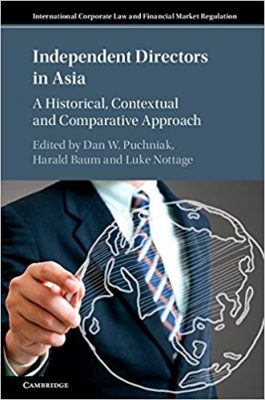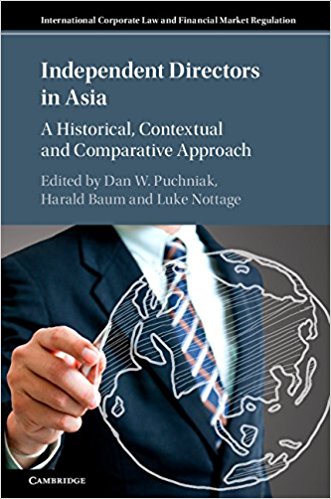 Editors: Dan W. Puchniak, Harald Baum, and Luke Nottage
Editors: Dan W. Puchniak, Harald Baum, and Luke Nottage
Publisher: Cambridge University Press – 619 pages
Book Review by: Paiso Jamakar
In 1996, the International Monetary Fund described the economic growth since 1960 of East Asia (it designated 10 countries into this region – China, Hong Kong, Indonesia, Japan, Malaysia, Philippines, Singapore, South Korea, Taiwan, and Thailand) since 1960 as no less than ‘spectacular’ Of these, the ‘Four Tigers’ had ‘phenomenal’ growth: Hong Kong, Singapore, South Korea and Taiwan.
Michael Sarel, author of the September 1996 IMF report on its website, wrote: that the Four Tigers were known as such “because of their powerful and intimidating economic performance. The Tigers have had annual growth rates of output per person well in excess of 6 percent.
These growth rates, sustained over a 30-year period, are simply amazing. While the average resident of a non-Asian country was 72 percent richer than his parents were in 1960, the corresponding figure for the average Korean is no less than 638 percent.”
Fast forward to 2018, and most of these East Asian countries (including probably Vietnam) have reached what I would describe as a good level of development, although there is always room for improvement. Some of them have become victims of their own success, with increased competition.
Mechanisms to prevent encroachment of their resources by competitors may be needed by a number of multinational companies at some of their Asian or regional offices. There is an ever-present need to have the right amount of regulation and maintain fairness
Because Asia, particularly East Asia has had higher levels of economic growth after 1960 compared to European countries and the United States, thousands of multinational corporations from the West established branches and partnerships in Asian capitals. Over the decades, the relationships between Asian directors of these multinational firms and their Western counterparts have been changing, some to the benefit, while others to the detriment, of one or the other side.
This book is about the evolution of such relationships. Nineteen specialists in business, economic, international, and political law, from 10 countries – Australia, China, Germany, Hong Kong, India, Japan, Singapore, Taiwan, the United Kingdom, and the United States – authored the 13 chapters of this book on international corporate law and financial market regulation.
Here below are the titles of the chapters organized are three Parts that provide you an overview of this book’s contents:
- Part I. Theoretical Framework
- The Rise of the Independent Director in the West: Understanding the Origins of Asia’s L:egal Transplants
- Independent Directors: A Theoretical Framework
- Variety of Independent Directors in Asia: A Taxonomy
- Asian Jurisdiction-Specific Chapters
- Japan’s Gradual Reception of Independent Directors: An Empirical and Political-Economic Analysis
- Korea’s Mandatory Independent Directors: Expected and Unexpected Roles
- Independent Directors in China: Facts and Reform Proposals’
- From Double Board to Unitary Board
- Independent Directors in Hong Kong
- Independent Directors in Singapore: A Corporate Government
- Board Independence in India: From Form to Function?
- Alternative Perspectives and Conclusions
- The Rise and Unlikely Demise of Independent Directors in Australia
- Case Studies of Independent Directors in Asia
- Independent Directors in Asia: Theoretical Lessons and Practical Implications
This 2017 book begins with a statement by the editors: “The rise of the independent director in Asia is now an issue of global consequence that has been largely overlooked until recently. Less than two decades ago, independent directors were an oddity in boardrooms. Today they are ubiquitous.” This text aims to take a closer at this issue, to change the situation from ‘overlooked’ to ‘looked at’
The idea of having independent board directors of U.S. multinational firms in other countries began in the 1970s. It was not ‘an Asian invention,’ write the editors.
Because corporate laws on board directors and their practice vary from country to country, conflicts arise between Asian directors and their American and European counterparts at multinational firms. The case studies presented in this text reveal the many varieties of independent directors in Asia. But none of these varieties “conform to the original American concept,” contend the editors.
This book sheds much light on the subject of independent board directors, and is a pioneering work. For this and other reasons, it holds much value and importance for management boards at multinational corporations.
Editors:
Dan W. Puchniak is Associate Professor at the National University of Singapore Faculty of Law, and Director of the Center for Asian Legal Studies at that university.
Harald Baum is Senior Research Fellow at the Max Planck Institute for Comparative and International Private Law in Hamburg, and is Professor of Law at the University of Hamburg in Hamburg, Germany.
Luke Nottage is Professor of Law at the University of Sydney Law School in Sydney, Australia.







